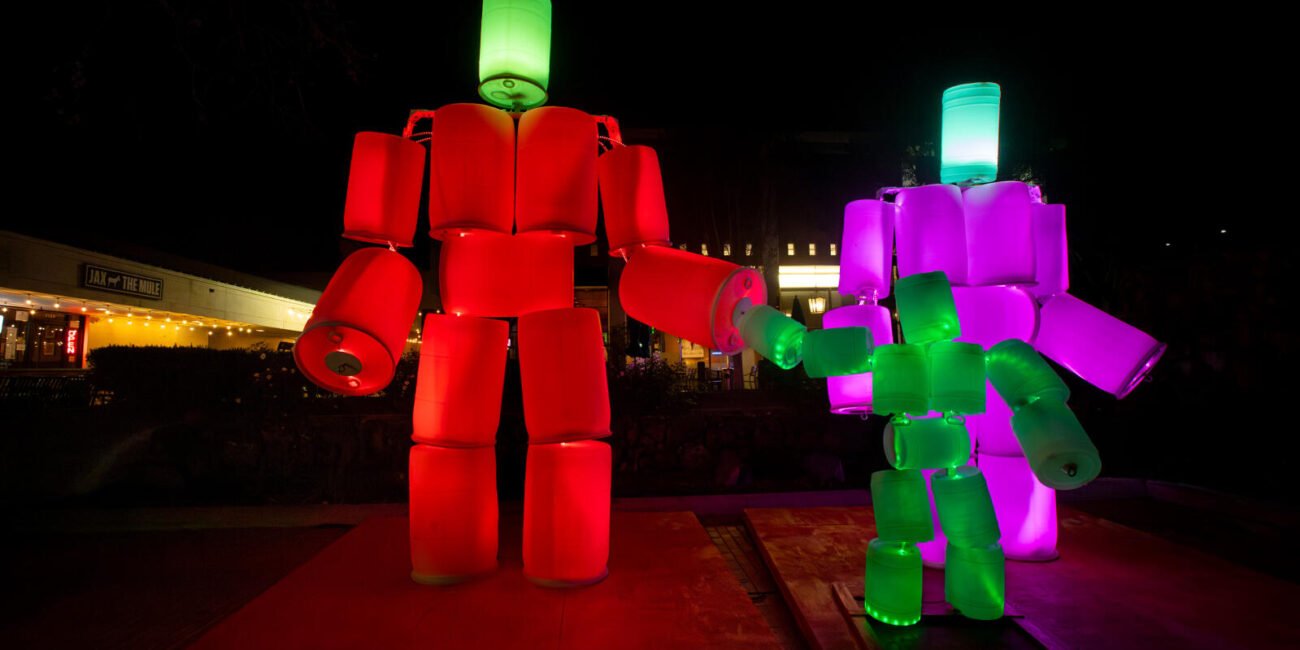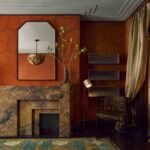Now in its seventh year, the event features 17 installations that transform the city’s historic streets, plazas and parks into a wonderland of light and creativity.
After driving cross-country in a rented box truck from his home outside Minneapolis, artist Joel Edward Sisson arrived in Napa last week with the simple goal: to put smiles on people’s faces at the city’s annual Lighted Art Festival.
Accompanied by his labradoodle, Girl, the 63-year-old artist transformed plastic barrels and lights he brought with him into a whimsical, human-like family of four. The installation, including a 17-foot father figure, now stands in a downtown Napa plaza. With its playful simplicity, “Barrel Boy and Friends” invites viewers to embrace their inner child.
“I like when people come around the corner and see them all of a sudden,” Sisson said. “There’s a smile that grows on their faces. I like for adults to remember what it’s like to be a kid again.”
Unlike some of the festival’s high-tech installations, Sisson’s creation feels deliberately homespun. He designed it to inspire people to think they could make something like it, too, even if they might need a few thousand dollars and a trip to Home Depot to pull it off.
The Lighted Art Festival, which opens Saturday and runs through Feb. 16, has become a winter staple for Napa. Now in its seventh year, the event features 17 installations that transform the city’s historic streets, plazas and parks into a wonderland of light and creativity. Each piece offers a unique blend of art and technology, drawing visitors from near and far.
Among the festival’s most advanced installations is “Fences,” a 7-foot tall, 72-foot long structure in Napa’a Oxbow District. Designed by Philadelphia-based artist Nicholas Lavella, the interactive piece tracks viewers’ movements using nearly 9,000 individually controlled LED lights. As people walk along the installation, patterns of light and shape ripple and respond, creating a dynamic interplay between art and audience.
It’s about changing perspectives, Lavella said during a test of the system Thursday night. It takes something ordinary — a downtown sidewalk — and transforms it into something magical.
“Plus, it’s fun,” he said.
“Waterlight Graffiti,” located in the Napa Town Center on First Street, also invites interaction. French artist Antonin Fourneau created the installation to let people draw or write using water. When droplets touch the surface, embedded LEDs glow, producing temporary, glowing works of art that vanish as the water evaporates.
The festival’s massive light projections are equally mesmerizing. On Brown Street, Ukrainian Svitlana Reinish has turned Napa County’s historic Superior Court building into a dreamscape with “The Dream Factory,” an intricate projection piece that blends surreal imagery with storytelling. Across town, French artists Leslie Epsztein and Camille Gross bring a cosmic theme to the historic First Presbyterian Church with “Elementa,” a psychedelic fresco inspired by the five fundamental elements of Earth, Water, Air, Fire and Aether. Their work reimagines the church’s 1874 neo-Gothic facade as a canvas for cosmic exploration.
Another standout projection, “Acts of Holding Dance,” graces the Native Sons of the Golden West building on Coombs Street. Australian choreographer and media artist Wendy Yu’s piece combines dance and digital art to create a visually striking experience.
While the projections are on display for the festival’s first nine days, other installations remain through the event’s duration, giving visitors plenty of opportunities to explore.
Beyond the art, the festival has become an economic and cultural boon for Napa. Created in 2018 by the city’s Parks and Recreation Department to attract visitors during slower months, the event has grown significantly. The 2024 festival brought an estimated 70,000 people downtown, generating between $3 million and $4 million in economic impact, said Katrina Gregory, Napa’s recreation and public arts manager. The second Saturday alone drew the highest number of visitors downtown in seven years, based on cell phone data.
“Obviously, a lot of residents are enjoying it and sometimes coming down multiple times with their family and friends,” Gregory said. And word has also gotten out around the Bay Area — “more people are taking a trip to Napa in the wintertime.”
Funding for the festival comes from multiple sources, including Napa Valley’s Tourism Improvement District, which assesses taxes on lodging businesses, as well as the city’s general fund and property owners who host art installations. This year’s budget of $340,000 supports not only the art but also free public events, including a new family-friendly attraction.
On Feb. 8, families can attend a free “Glow Party” at 1151 Pearl St., a former transit stop. The event, sponsored by the Children’s Museum of Napa Valley and the Napa Parks & Recreation Foundation, will feature music, dancing, and the opportunity to interact with “Down the Rabbit Hole,” an installation by Colorado-based artists Darrell E. Ansted and Katie D’Arcangelo.
Rain or shine, the festival runs from 6 to 9 p.m. Sunday through Thursday and extends to 10 p.m. on Fridays and Saturdays. For Napa, the Lighted Art Festival isn’t just a visual spectacle — it’s a celebration of creativity, community, and connection during the heart of winter.




No Comment! Be the first one.